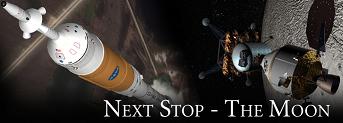This year the Orion program was launched, the shuttles returned to normal, an upgrade mission to the Hubble Space Telescope was announced, the hole in the ozone grew, it was discovered that water has flowed on Mars for the past seven years and more

The Orion program was launched:After unveiling the US national strategy for manned space exploration in December, NASA announced that it would return to the moon by 2020, and develop an operational lunar base in the following years. Six-month missions to the base will be used to prepare longer missions - to Mars. Earlier this year, NASA announced the names of the aircraft that will be used for the flight to the moon: Orion - the crew cabin, Ares 1 - the launch vehicle for the manned missions and Ares 6 - the cargo launcher.
The ferries are back to normal:Three shuttle flights took place in 2006, the first year in which there was more than one flight since 2002. The first flight showed that the fixes made since the test mission in 2005 were indeed working. In the next two missions, the astronauts renewed the assembly of the International Space Station, added new components to the station and increased the power generation capacity available for conducting scientific experiments.
The soul to mourn: Nas"A announced that it will send another shuttle to upgrade and refurbish the Hubble Space Telescope, thereby extending its active life and adding two new instruments to it.
Wet Mars:While the new spacecraft the Mars Reconnaissance Orbiter transmitted the highest resolution images to date, the twin robotic vehicles Spirit and Opportunity continued their amazing journey that lasted far beyond their predicted lifespan. In December, data from the Mars Global Surveyor spacecraft indicated that water has flowed in spurts on the surface of Mars over the past seven years. In July, NASA celebrated the 30th anniversary of the landing of the Viking spacecraft - the first Mars landers. It's just a shame that after this amazing discovery, and after ten years in space, contact with the Mars Global Surveyor spacecraft was lost.
Cassini explores Saturn and its moons: The Cassini spacecraft has passed the midpoint of its mission and continues to discover surprising things. In March of this year, the spacecraft found possible evidence of reservoirs of liquid water erupting from Yellowstone-like geysers on Saturn's moon Enceladus. In July, Cassini revealed an area the size of Australia that resembles Earth and methane lakes on the moon Titan.
New Horizon to Pluto:On January 19, the first mission to Pluto was launched - New Horizons took off from Earth at a speed of 50 km/h and became the fastest spacecraft ever launched. Immediately after launch, the Hubble Space Telescope confirmed the existence of two additional moons orbiting Pluto. New Horizons, which is supposed to reach Pluto in 2015, was able to view its destination during a camera test in September.
Climate research:NASA's Earth research provided two new discoveries during 2006 about our planet and its climate. The agency launched the first satellite that will provide XNUMXD images of the clouds as well as a weather satellite that will provide ongoing environmental information to meteorologists and the public. NASA also completed a "train" of six holiday satellites in close proximity to each other around the Earth to gain a better understanding of important factors related to climate change. The activity of the researchers includes a comprehensive study of hurricanes as well as a study of the way in which the winds and dust from Africa affect the tropical cyclones in the Atlantic Ocean.
The scientists investigated the discovery that the area and depth of the hole in the ozone this year was the largest ever. The scientists also observed a reduction in the source of the marine food chain, which could harm the fish and the ecosystem as the climate warms. The researchers also examined the impact of air pollution movement around the world, improved tracking of large wildfires and hurricanes, and studied changes in the global ice and snow landscape. The scientists declared, based on the average temperature studies, that 2005 was one of the hottest years in the last century and 2006 was among the ten worst.
Exploring the Sun:NASA gave its Internet surfers and TV viewers a front row seat to the March 28 solar eclipse. A live broadcast brought the eclipse seen along a path starting from South America, through Africa to Asia - to schools and museums, and to personal computers around the world. NASA and Libyan scientists observed and studied the event.
Nobel Prize for NASA:On December 10, Dr. John Mader of NASA's Goddard Center received the 2006 Nobel Prize in Physics in Stockholm, Sweden. Mader is the first NASA official to win a Nobel Prize. Mader and George Smoot from the University of California at Berkeley were recognized for findings they made using NASA's Cosmic Background Explorer, they helped confirm the Big Bang theory as the cause of the origin of the universe.

One response
Beautiful site